Tariffs and Shipping Delays
All items that are in stock, listed to the right, are in the USA and are not subject to tariffs or shipping delays. If you want premium trout rods, they're here now.
Daiwa Crusader Spoons
Daiwa Crusader Spoons have been around for thirty years. In a country
that values "new and improved" as highly as Japan does, that says a
lot. It also says a lot that they are marketed for both "Areas" and
native trout. The lures intended for Areas (stocked pay-to-fish lakes)
and for mountain streams tend to be quite different. That
the Crusader spoons have been around for so long and are sold for both stocked trout and native trout means only one thing - they work! The very first time I
tried them I was definitely convinced!
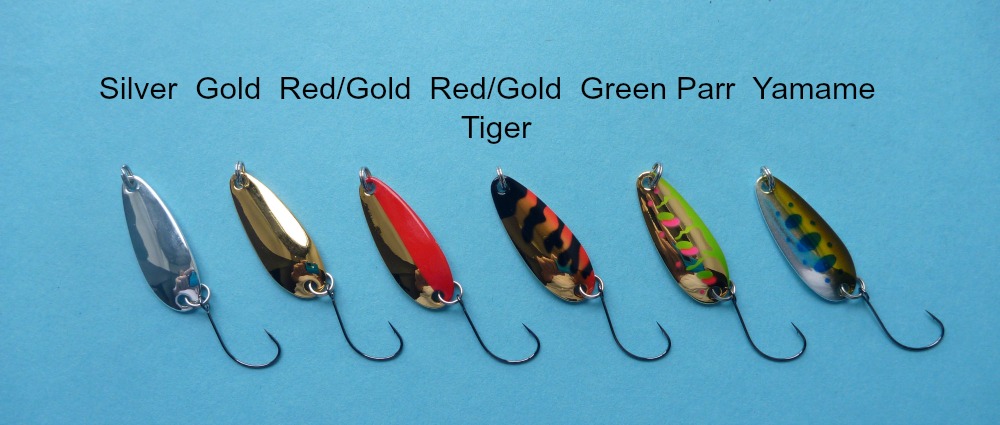 Daiwa Crusader Spoons 2.5g, selected colors
Daiwa Crusader Spoons 2.5g, selected colorsThe 2.5g spoons are roughly 1/12 oz and in weight; just under 1 1/8" in length. (They come in larger sizes as well, but the 2.5g spoons work just fine, and I do not believe larger ones are necessary for trout in mountain streams.)
In the US, spinners are more popular than either spoons or plugs for trout fishing in streams and lakes. In Japan, plugs are far more popular than spinners in streams, and spoons are far more popular than spinners in the Areas. I had initially thought that was because spinners tend to cause line twist. Premium Japanese line, whether for spinning or BFS (Bait Finesse System - essentially an ultralight baitcaster), is considerably more expensive than the spinning line most American anglers use.
Additionally, Japanese anglers tend to use lighter line, and Japanese spinning line is both thinner (for the same pound test rating) and softer than most line available in the US. I had thought that rather than fishing spinners and replacing twisted line frequently, Japanese anglers would tend to favor lures that cause less line twist to begin with.
I was later told by two Japanese anglers that the real reason few Japanese fish spinners is because they think catching trout on spinners is too easy. Rather than just casting out and reeling in, working the lure is more interesting.
For me, though, the lack of line twist is the major reason I prefer spoons over spinners.
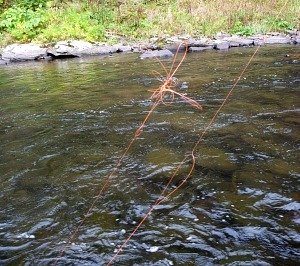 Line twist caused by a spinner
Line twist caused by a spinnerI have read that line twist is caused by closing the bail on a spinning reel, and that the solution is to cut off the bail and picking up the line with your finger as your begin your retrieve. I don't believe it. I am convinced the most line twist is caused by spinners themselves. It's not just the blade that spins. The whole spinner spins and as it does it twists the line. Using a swivel does not eliminate line twist. Watch carefully, it is pretty easy to see the whole spinner spinning as you finish your retrieve.
The photo above shows twisted line caused by a spinner. I know for a fact it was not caused by the spinning reel bail because I was using a baitcaster. Baitcasters definitely do not twist the line!
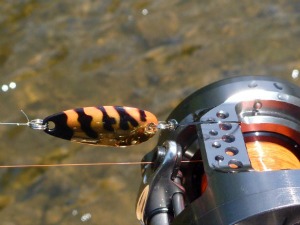 Daiwa Crusader Red Gold Tiger 2.5g
Daiwa Crusader Red Gold Tiger 2.5gUnlike spinners, for which the blade spins in one direction for the entire retrieve, the Daiwa Crusader spoons wobble rather than spin if you fish them as slowly as they should be fished. If you retrieve them too fast, they will spin, but they don't always spin the same direction. They'll spin one way, then wobble a bit, then spin the other way for a while and then start wobbling again. That dramatically reduces line twist, while still having all the flash you could want. Just the wobbling is sufficient though! There is no need to fish spoons so fast that they spin.
Actually, I would put it more strongly. You should not fish a spoon so fast that it spins. The lack of spin is the primary advantage of a spoon over a spinner. Really well designed spinners cause very little line twist, but with a spoon there is no reason to have any line twist. A second advantage of a spoon over a spinner is that it is easier to cast. The spinner blade flutters, which causes more drag through the air, so a spoon will fly further with the same force applied to the cast, or will fly to your target with less casting force than a spinner would require. A third advantage is that they cost less than spinners.
The more erratic
action also seems to elicit a very different response from the trout.
With a spinner, trout will either ignore it, follow it or hit it. Lots of
fish just follow, and those that hit it will only hit it once. If they
don't get hooked, you don't get a second chance. With the Daiwa Crusader
spoons, I seemed to get fewer follows and more fish slashing at it. If
they miss it the first time (which seems to be common, probably because
of the erratic action), they tend to slash at it again. What's more,
they'll often hit it more than once. I've caught fish that got hooked
the fourth time they hit the spoon! I've also had three or four trout
competing to get it.
I suspect the hookup percentage would be higher if the Daiwa Crusader spoons had treble hooks, but they come with a single hook. Once a couple years ago, fishing with a Mepps spinner, I caught a small trout that managed to get all three of the hooks in its mouth. Trying to get all three hooks unhooked, quickly enough that the fish didn't die and gently enough that its mouth was still intact, made me vow "never again!"
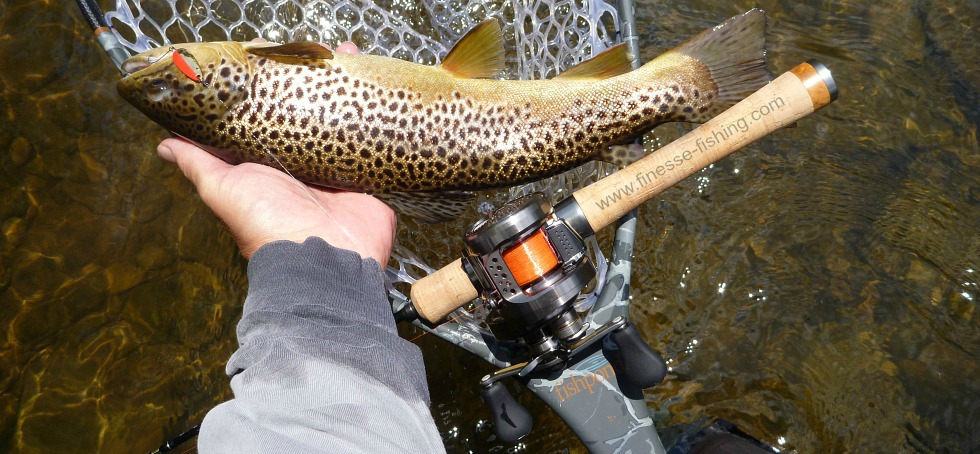 Daiwa Crusader Gold-Red Spoon
Daiwa Crusader Gold-Red SpoonThe first time I tried the Daiwa Crusader spoons I wanted to cycle through all the colors I'd ordered. Might be foolish, but I wanted to make sure they all worked. They all worked. One, however, seemed to work better than the other five. (The "test" was not even close to scientific and suffered tremendously from what statisticians would call a small sample size. Thus, it was essentially worthless, but it didn't matter - I had a favorite color.) I really liked the Gold-Red spoon. I liked it well enough that I ordered more (before having sold even one) and also ordered some in the larger 4 gram size.
 Male Redside Dace. Brian Zimmerman photo.
Male Redside Dace. Brian Zimmerman photo. Used with permission.
The Gold-Red Daiwa Crusader spoon is half polished gold and half bright red. "Match the hatch" is not a phrase often uttered by spin fishermen, but I definitely think it applies to the Gold-Red spoon.
The breeding males of several small fish species have a bright red stripe on their side or belly. They will swim erratically, flashing their bright red sides to attract mates. The Gold-Red Daiwa Crusader spoon is a bit brighter, and the wobble is a bit more erratic, but it is close enough to a breeding redside dace, redbelly dace, rosyside dace or redside shiner that there is a biological reason for it to work, beyond just triggering an instinctive predatory response.
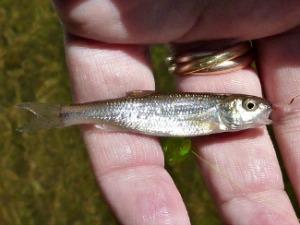 A silver spoon looks a lot like an immature fallfish.
A silver spoon looks a lot like an immature fallfish.The second stream on which I tried the Daiwa Crusader spoons is one that has lots of juvenile fallfish and some common shiners, both of which are very silvery. As could be expected, the plain silver spoon worked better there. And boy, did it work! I had the best day I'd ever had on that stream. My friend Coach, who was tenkara fishing that day, and who is not used to getting outfished on his home water, said next time he'd bring spinning gear, too, muttering something about me luring him to the dark side.
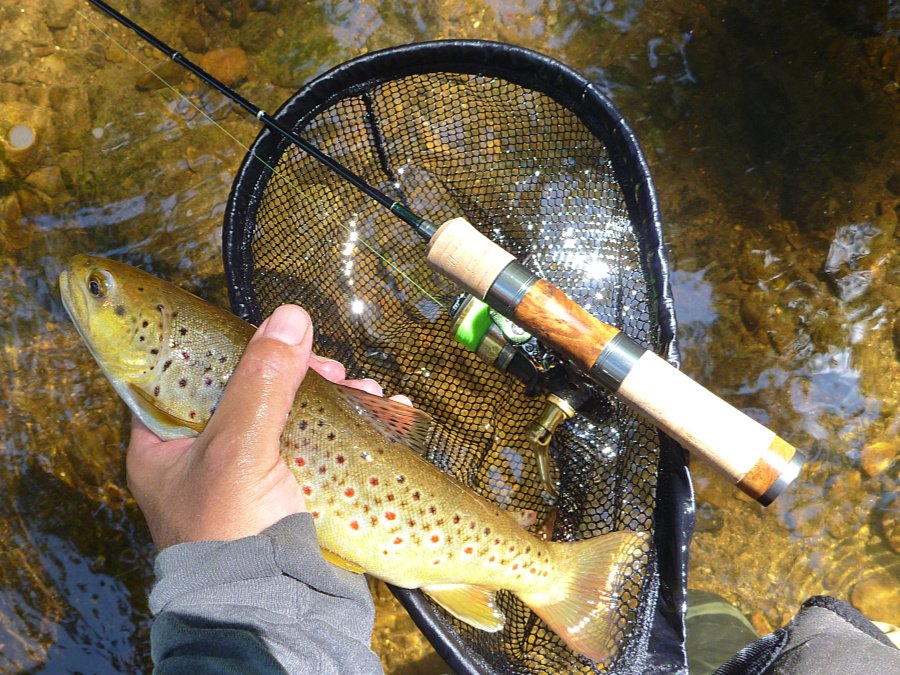 Effective the Dark Side is.
Effective the Dark Side is.The Daiwa Crusader spoons are carefully
made with great attention to detail. You might think, "hey, it's just a
spoon" but I have seen spoons that were neither as well made nor as well
finished as these. They are a bit more expensive than the spoons you can
buy in the big box stores, but as a percentage of the cost of your full
set up or your entire trip, the difference is minor. Besides, if they catch fish for you as well as they have for me, does it really matter if they're a little more expensive? I've been told by customers that even if they are more expensive, they'll keep buying them because they're more effective.
The only
aspect of the spoons that I find less than ideal is that the hook they come with is
just large enough to catch the line in front of the spoon, probably on the cast. Next time I try them I will substitute a C'ultiva replacement barbless hook, which has a slightly shorter shank. Even with the single hook, which I suspect caused me to miss some hits; and even with the occasional fouling on the line, I still caught more than
enough fish. Prior to writing this page I had used the Daiwa Crusader Spoons on just two days,
and on just two streams. On each day, though, I caught more fish than I had ever caught on that stream before. I am sure that record will not hold
for every day and for every stream, but I was very impressed with
the spoons.
So was Coach, who after we quit fishing for the day bought almost all the silver spoons I had in stock.
Update 8/3/17
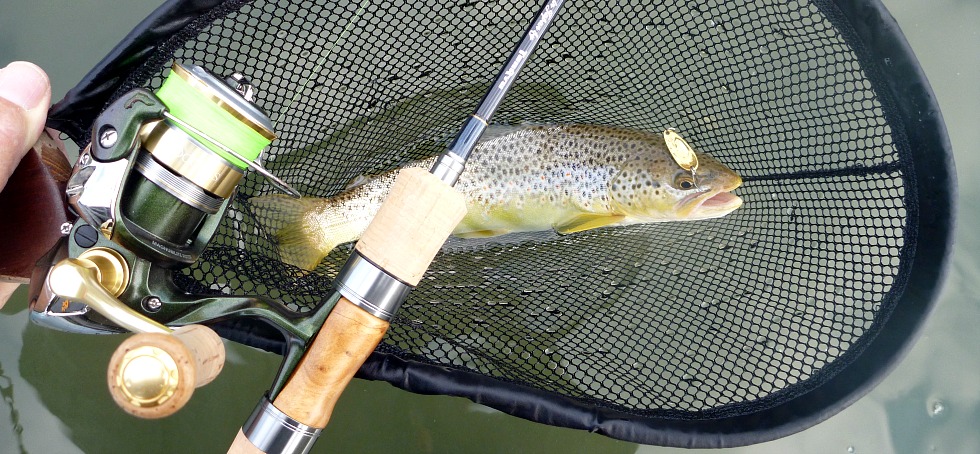 The more I use the Crusader spoons the better I like them
The more I use the Crusader spoons the better I like themI have now used the Daiwa Crusader Spoons in several streams and the more I use them the better I Iike them. Replacing the original hook with a Cultiva SBL-35, size 8 does indeed reduce the number of times the hook catches on the line. The SBL-35 hooks hold well too (other than on really little fish, which will wriggle off any barbless hook).
I have also found that the other colors also work just fine. Since that first day where the red-gold spoon seemed to do best, I have not been able to determine that one was any better than the others.
Update 6/7/18
Although I imported the spoons for trout, and I do use them primarily for trout, they do work on other species.
One thing I learned fishing the spoons for smallmouth bass is that they work a lot better if fished slowly. I started out fishing them at what I thought was the proper speed - so the would spin a bit, then wobble a bit, then spin the other direction, and then wobble some more. I eventually discovered that if I fished them slowly enough that they would wobble but not spin, I started getting a lot more hits. If you fish them very slowly, they barely wobble at all. However, if you fish them that slowly, but give the rod tip very subtle twitches, the spoons wobble quite a bit but still travel very slowly.
I have not yet tried that very slow speed retrieve for trout, but a friend told me he experienced the same thing when fishing for trout in the alpine lakes of Colorado. He said the fish wanted a very slow retrieve. The spoons still wobble, and still flash, but they don't spin. You get absolutely no line twist if you fish the spoons slowly. They may be a lot easier for the fish to catch, too. I have since fished them that slowly for trout, and I am convinced that fishing spoons slowly enough that they wobble but do not spin is the better way to fish spoons.
Finesse-Fishing Home > Single Hook Lures > Daiwa Crusader Spoons
Header photo: Tenryu Rayz RZ4102B-UL, Shimano Calcutta Conquest BFS-HG ('17)
Warning:
The hooks are sharp.
The coffee's hot.
The fish are slippery when wet.
Whatever you do, do it with finesse!